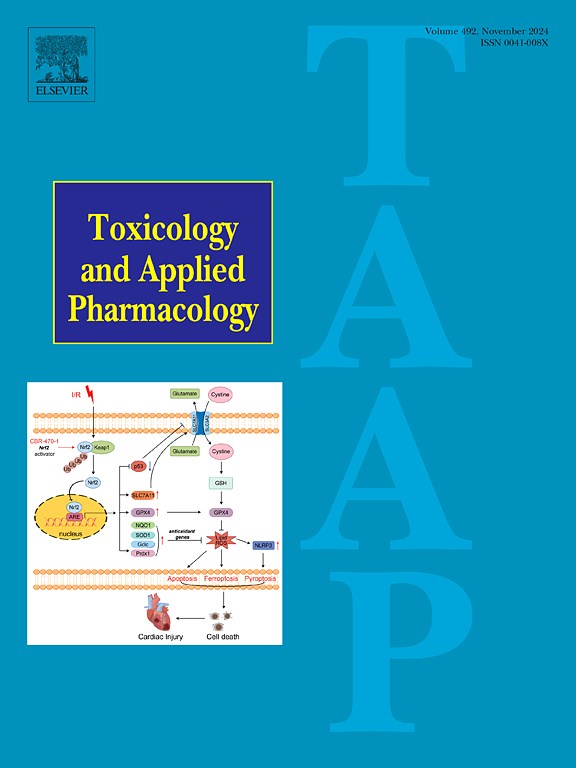Melatonin ameliorates PM2.5-induced airway inflammation and apoptosis by PERK/eIF2α/ATF4/CHOP in chronic obstructive pulmonary disease mice
IF 3.3
3区 医学
Q2 PHARMACOLOGY & PHARMACY
引用次数: 0
Abstract
Fine particulate matter (PM2.5) has been reported to exacerbate chronic airway inflammation, contributing to progression and acute exacerbation of chronic obstructive pulmonary disease (COPD). Persistent activated endoplasmic reticulum (ER) stress-related PERK/eIF2α/ATF4/CHOP pathway is critical in driving inflammation and cell death in a variety of inflammatory diseases. Melatonin (MEL) is well-recognized for its broad biological activities, such as anti-oxidative and anti-inflammatory effects However, the exact role of ER stress-related pathway and MEL in PM2.5-induced airway inflammation and apoptosis in COPD has not yet been elucidated. Therefore, we constructed the COPD mice model by cigarette smoke (CS) exposure to evaluate the mechanism by which PM2.5 exacerbate the development of COPD and the protective role of MEL. Results indicated that PM2.5 significantly impair lung function, disrupt emphysema, exacerbate inflammation and apoptosis and intensify the PERK/eIF2α/ATF4/CHOP pathway in COPD mice. Moreover, these changes caused by PM2.5 could be mitigated by MEL. In vitro, PM2.5 exposure notably reduced cell viability and triggered inflammation and apoptosis in BEAS-2B cells induced by cigarette smoke extract (CSE). These effects were reversed by the ER stress inhibitor 4-phenylbutyric acid (4-PBA), with MEL demonstrating similar effect. These findings demonstrate that PM2.5 aggravates airway inflammation and apoptosis via activating ER stress-related PERK/eIF2α/ATF4/CHOP pathways in COPD, which could be significantly restored by MEL.

褪黑素通过PERK/eIF2α/ATF4/CHOP改善pm2.5诱导的慢性阻塞性肺疾病小鼠气道炎症和细胞凋亡。
据报道,细颗粒物(PM2.5)会加剧慢性气道炎症,导致慢性阻塞性肺疾病(COPD)的进展和急性加重。持续激活的内质网(ER)应激相关的PERK/eIF2α/ATF4/CHOP通路在多种炎症性疾病中驱动炎症和细胞死亡至关重要。褪黑素(MEL)具有广泛的生物活性,如抗氧化和抗炎作用,但内质网应激相关途径和MEL在pm2.5诱导的COPD气道炎症和细胞凋亡中的确切作用尚未阐明。因此,我们构建了COPD小鼠香烟烟雾暴露模型,以评估PM2.5加剧COPD发展的机制和MEL的保护作用。结果表明,PM2.5显著损害COPD小鼠肺功能,破坏肺气肿,加重炎症和细胞凋亡,增强PERK/eIF2α/ATF4/CHOP通路。此外,PM2.5引起的这些变化可以通过MEL来缓解。在体外,PM2.5暴露显著降低了香烟烟雾提取物(CSE)诱导的BEAS-2B细胞的细胞活力,并引发了炎症和凋亡。这些作用被内质网应激抑制剂4-苯基丁酸(4-PBA)逆转,MEL也表现出类似的效果。这些研究结果表明,PM2.5通过激活内膜应激相关的PERK/eIF2α/ATF4/CHOP通路加重COPD气道炎症和凋亡,MEL可显著恢复这一通路。
本文章由计算机程序翻译,如有差异,请以英文原文为准。
求助全文
约1分钟内获得全文
求助全文
来源期刊
CiteScore
6.80
自引率
2.60%
发文量
309
审稿时长
32 days
期刊介绍:
Toxicology and Applied Pharmacology publishes original scientific research of relevance to animals or humans pertaining to the action of chemicals, drugs, or chemically-defined natural products.
Regular articles address mechanistic approaches to physiological, pharmacologic, biochemical, cellular, or molecular understanding of toxicologic/pathologic lesions and to methods used to describe these responses. Safety Science articles address outstanding state-of-the-art preclinical and human translational characterization of drug and chemical safety employing cutting-edge science. Highly significant Regulatory Safety Science articles will also be considered in this category. Papers concerned with alternatives to the use of experimental animals are encouraged.
Short articles report on high impact studies of broad interest to readers of TAAP that would benefit from rapid publication. These articles should contain no more than a combined total of four figures and tables. Authors should include in their cover letter the justification for consideration of their manuscript as a short article.

 求助内容:
求助内容: 应助结果提醒方式:
应助结果提醒方式:


